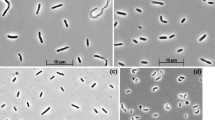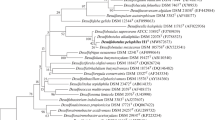Abstract
A new type of sulfate-reducing bacteria with ellipsoidal to lemon-shaped cells was regularly enriched from anaerobic freshwater and marine mud samples when mineral media with propionate and sulfate were used. Three strains (1pr3, 2pr4, 3pr10) were isolated in pure culture. Propionate, lactate and alcohols were used as electron donors and carbon sources. Growth on H2 required acetate as a carbon source in the presence of CO2. Stoichiometric measurements revealed that oxidation of propionate was incomplete and led to acetate as an endproduct. Instead of sulfate, strain 1pr3 was shown to reduce sulfite and thiosulfate to H2S; nitrate also served as electron acceptor and was reduced to ammonia. With lactate or pyruvate, all three strains were able to grow without external electron acceptor and formed propionate and acetate as fermentation products. None of the strains contained desulfoviridin. In strain 1pr3 cytochromes of the b- and c-type were identified. Strain 1pr3 is described as type strain of the new species and genus, Desulfobulbus propionicus.
Similar content being viewed by others
References
Ansbaek J, Blackburn TH (1980) A method for the analysis of acetate turnover in a coastal marine sediment. Microbiol Ecol 5:253–264
Baars JK (1930) Over sulfaatreductie door bacteriën. Proefschrift, Hoogeschool Delft (Holland). Meinema
Boone DR, Bryant MP (1980) Propionate-degrading bacterium, Syntrophobacter woolinii sp. nov. gen. nov., from methanogenic ecosystems. Appl Environ Microbiol 40:626–632
Campbell LL, Postgate JR (1965) Classification of the spore-forming sulfate-reducing bacteria. Bacteriol Rev 29:359–363
Golterman HL (1971) Methods for chemical analysis of fresh waters. Blackwell Scientific Publications, Oxford Edinburgh
Hungate RE (1966) The rumen and its microbes. Academic Press, New York London
Hvid-Hansen N (1951) Sulfate-reducing and hydrocarbon-producing bacteria in ground-water. Acta Pathol Microbiol Scand 29:266–289
Jankowski GJ, ZoBell CE (1944) Hydrocarbon production by sulfatereducing bacteria. J Bacteriol 47:447
Kaspar HF, Wuhrmann K (1978) Kinetic parameters and relative turnovers of some important catabolic reactions in digesting sludge. Appl Environ Microbiol 36:1–7
Laanbroek HJ, Pfennig N (1981) Oxidation of short-chain fatty acids by sulfate-reducing bacteria in freshwater and in marine sediments. Arch Microbiol 128:330–335
LeGall J, Postgate JR (1973) The physiology of sulfate-reducing bacteria. Adv Microb Physiol 10:81–133
Mayer F (1969) Die Fimbrien von Rhizobium lupini 1/50, sta-. Arch Mikrobiol 68:179–186
Postgate JR, Campbell LL (1966) Classification of Desulfovibrio species, the nonsporulating sulfate-reducing bacteria. Bacteriol Rev 30:732–738
Postgate JR (1979) The sulfate-reducing bacteria. Cambridge University Press, Cambridge
Sørensen J, Christensen D, Jørgensen BB (1981) Volatile fatty acid and hydrogen as substrates for sulfate-reducing bacteria in anaerobic marine sediment. Appl Environ Microbiol 42:5–11
Toerien DF, Hattingh WHJ (1969) Anaerobic digestion. I. The microbiology of anaerobic digestion. Water Res 3:385–416
Thauer RK, Jungermann K, Decker K (1977) Energy conservation in chemotrophic anaerobic bacteria. Bacteriol Rev 41:100–180
Tweedy JM, Park RWA, Hodgkiss W (1968) Evidence for the presence of fimbriae (pili) on vibrio species. J Gen Microbiol 51:235–244
Wake LV, Christopher RK, Rickard PAD, Andersen SE, Ralph BJ (1977) A thermodynamic assessment of possible substrates for sulphate-reducing bacteria. Aust J Biol Sci 30:155–172
Widdel F, Pfennig N (1981a) Studies on dissimilatory sulfate-reducing bacteria that decompose fatty acids. I. Isolation of new sulfatereducing bacteria enriched with acetate from saline environments. Description of Desulfobacter postgatei gen. nov., sp. nov. Arch Microbiol 129:395–400
Widdel F, Pfennig N (1981b) Sporulation and further nutritional characteristics of Desulfotomaculum acetoxidans. Arch Microbiol 129:401–402
Author information
Authors and Affiliations
Rights and permissions
About this article
Cite this article
Widdel, F., Pfennig, N. Studies on dissimilatory sulfate-reducing bacteria that decompose fatty acids II. Incomplete oxidation of propionate by Desulfobulbus propionicus gen. nov., sp. nov.. Arch. Microbiol. 131, 360–365 (1982). https://doi.org/10.1007/BF00411187
Received:
Accepted:
Issue Date:
DOI: https://doi.org/10.1007/BF00411187




